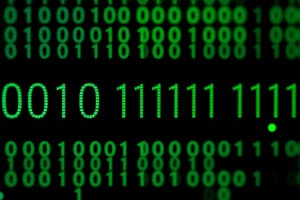Podcast
Questions and Answers
Which of the following correctly describes a nibble?
Which of the following correctly describes a nibble?
- A group of 2 bits
- A group of 6 bits
- A group of 4 bits (correct)
- A group of 8 bits
What is a byte composed of?
What is a byte composed of?
- 8 bits (correct)
- 16 bits
- 32 bits
- 4 bits
How is the decimal number 3 represented in binary?
How is the decimal number 3 represented in binary?
- 0001
- 0011 (correct)
- 0100
- 0010
What process is used to convert a decimal number to binary?
What process is used to convert a decimal number to binary?
Which of the following applications of binary representation is NOT correct?
Which of the following applications of binary representation is NOT correct?
Flashcards are hidden until you start studying
Study Notes
Binary Representation
-
Definition:
- Binary representation is the way data is encoded in a computer system using two symbols: 0 and 1.
-
Bit:
- The smallest unit of data in a computer, representing a state of either 0 (off) or 1 (on).
-
Byte:
- Consists of 8 bits.
- Can represent 256 different values (2^8).
-
Nibbles:
- A group of 4 bits.
- Represents 16 different values (2^4).
-
Binary Numbers:
- Comprised solely of 0s and 1s.
- Each position represents a power of 2, starting from the right (2^0, 2^1, 2^2, etc.).
-
Conversion:
- Decimal to Binary: Divide the decimal number by 2, record the remainder, and repeat until the quotient is 0. The binary representation is read from bottom to top.
- Binary to Decimal: Multiply each bit by 2 raised to the position index (from right) and sum the results.
-
Common Binary Values:
- Decimal 0 = Binary 0000
- Decimal 1 = Binary 0001
- Decimal 2 = Binary 0010
- Decimal 3 = Binary 0011
- Decimal 4 = Binary 0100
- Decimal 5 = Binary 0101
- Decimal 10 = Binary 1010
- Decimal 15 = Binary 1111
-
Applications:
- Used in computing for data representation (integers, characters, images).
- Essential for digital circuits and processors to perform calculations and store data.
-
Data Encoding Formats:
- ASCII: Represents characters using 7 or 8 bits.
- UTF-8: A variable-length encoding for Unicode characters, uses 1 to 4 bytes.
-
Logical Operations:
- Used to manipulate bits: AND, OR, NOT, XOR.
- Fundamental for performing calculations and data processing in chips.
This concise overview of binary representation highlights its significance in digital computing and chip data processing.
Binary Representation
- Binary representation uses 0s and 1s to encode data in computers
- It is the fundamental language of computers
Bits and Bytes
- A bit is the smallest unit of data, representing either on (1) or off (0)
- A byte is a group of 8 bits
- A byte can represent 256 different values (2 raised to the power of 8)
- A nibble is a group of 4 bits and can represent 16 values (2 raised to the power of 4)
Binary Numbers
- Numbers comprised solely of 0s and 1s
- Each position in a binary number represents a power of 2, starting from the rightmost position (2^0, 2^1, 2^2, etc.)
- To convert from decimal to binary, repeatedly divide the decimal number by 2, keeping track of the remainders
- Read the remainders from bottom to top to get the binary representation
- To convert from binary to decimal, multiply each bit by 2 raised to its position index (starting from the rightmost position) and sum the results
Applications of Binary Representation
- Data Representation: Used for integers, characters, images
- Digital Circuits and Processors: Essential for calculations and data storage
- Data Encoding Formats
- ASCII: Uses 7 or 8 bits to represent characters
- UTF-8: Variable-length encoding for Unicode characters, using 1 to 4 bytes
Logical Operations in Binary
- Operations like AND, OR, NOT, XOR manipulate bits
- Essential for calculations and data processing in chips
Studying That Suits You
Use AI to generate personalized quizzes and flashcards to suit your learning preferences.




